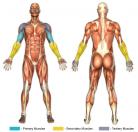3-Part Curls / 21s (Dumbbell)
- Grasp a dumbbell of desired weight in each hand (keeping in mind that 21 consecutive repetitions are performed when doing this exercise) and, either sit on a bench or stand upright (with legs about shoulder-width apart), letting your arms hang at your sides. Note: Generally this exercise is done with the forearms supinated (thumbs pointing outward). See "Further Clarification" for more details.
- Bottom Portion. Begin by curling the weights upward until your forearms are parallel with the ground, i.e. stop when you reach halfway up (midpoint), while exhaling throughout the movement.
- Lower the weights to the initial position, while inhaling throughout the movement.
- Repeat steps 2-3 until a total of 7 repetitions are reached.
- Top Portion. Without resting, curl the weights completely to top as you would in a traditional biceps curl, while exhaling throughout the movement.
- Lower the weights until your forearms are parallel to the ground, i.e. stop when you reach halfway down (midpoint), while inhaling throughout the movement. (Notice that since your first curl was a complete curl, when you now lower the weight only halfway you are working only the top portion of a traditional biceps curl.)
- Repeat steps 5-6 until a total of 7 repetitions is reached, lowering the weights all the way down on the last (7th) repetition.
- Full-Range Curls. Once again without resting, curl the weights the entire range, exhaling throughout the movement.
- Lower the weights to the bottom, inhaling throughout the movement.
- Repeat steps 8-9 until a total of 7 repetitions are reached.
- Rest!
Performing this exercise in front of a mirror may aid in assuring that proper form is achieved, as working within the pre-designated ranges is preferred. This exercise is bestowed its nickname, 21s, because its 3 sets of 7 repetitions equals 21 total repetitions.
The curling motion can be performed three ways: alternating arms, both arms at the same time, or one arm at a time.
3-part curls allow for self-spotting, if one arm is exercised at a time. This is an additionally appealing byproduct of using dumbbells. To self-spot on curls, simply use your free hand to gently help (via touch spot) the working arm to raise the weight when it becomes too difficult to lift unassisted.
By merely changing the way your forearm (and, consequently, hand) is positioned you can adjust which/(how the) muscles will be targeted, to at least some degree; this is done through pronation and supination of the forearm. Supination is the position of your forearm when your palm is facing outward/upward, and, conversely, pronation is when your palm is facing inward. Note that for most people anatomy will inhibit the forearm from pronating as far inward as it will allow the forearm to supinate outward.
So, to emphasize the biceps brachii, keep your forearm supinated (so that your thumb is pointed outward, i.e. your palm is facing outward/forward in respect to your body); to incorporate more brachioradialis, pronate your forearm (so that your thumb is pointed up, i.e. your palm is facing inward in respect to your body). In the case of curls, keeping the hand position neutral is the "hammer curl" variety of curls.
Some people may develop elbow (tendon) pain if they do curls incorrectly. Three things to remember to greatly reduce the chance of elbow injury are:
- Always control the weight, especially during the down movement. Letting the weight drop as the elbow reaches the bottom "locked" position causes tremendous stress on it that will eventually likely result in injury.
- Keep your wrists straight (neutral). It is in this manner that maximum biceps stress will be achieved. Bending your wrist in either direction (upward or downward) removes focus from the intended muscle, the biceps, and creates vulnerability to injury (elbow or wrist).
- Keep your elbows at your side throughout the movement, especially if you are a novice. Many people can raise their elbows (forward) at the top of the curl movement without becoming injured, though by raising the elbows the anterior deltoids become far more involved. If you are looking for a shoulder workout, then shoulder exercises better serve this purpose. However, there are experts who claim that raising the elbows forward allows for a fuller contraction of the biceps. Use good judgment when determining whether or not to perform curls this way.





